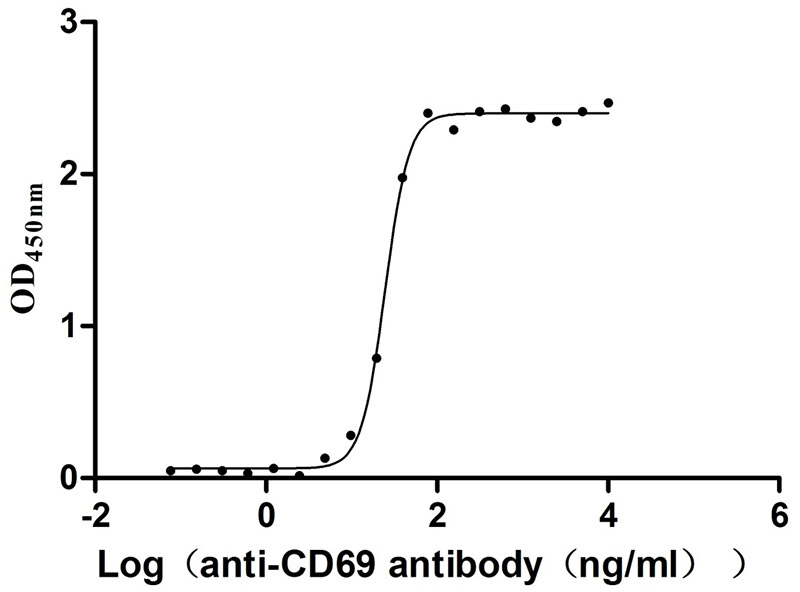Recombinant Mouse ATP-sensitive inward rectifier potassium channel 10 (Kcnj10), partial
-
中文名称:小鼠Kcnj10重组蛋白
-
货号:CSB-YP878111MO1
-
规格:
-
来源:Yeast
-
其他:
-
中文名称:小鼠Kcnj10重组蛋白
-
货号:CSB-EP878111MO1
-
规格:
-
来源:E.coli
-
其他:
-
中文名称:小鼠Kcnj10重组蛋白
-
货号:CSB-EP878111MO1-B
-
规格:
-
来源:E.coli
-
共轭:Avi-tag Biotinylated
E. coli biotin ligase (BirA) is highly specific in covalently attaching biotin to the 15 amino acid AviTag peptide. This recombinant protein was biotinylated in vivo by AviTag-BirA technology, which method is BriA catalyzes amide linkage between the biotin and the specific lysine of the AviTag.
-
其他:
-
中文名称:小鼠Kcnj10重组蛋白
-
货号:CSB-BP878111MO1
-
规格:
-
来源:Baculovirus
-
其他:
-
中文名称:小鼠Kcnj10重组蛋白
-
货号:CSB-MP878111MO1
-
规格:
-
来源:Mammalian cell
-
其他:
产品详情
-
纯度:>85% (SDS-PAGE)
-
基因名:Kcnj10
-
Uniprot No.:
-
别名:Kcnj10; ATP-sensitive inward rectifier potassium channel 10; Inward rectifier K(+ channel Kir4.1; Potassium channel, inwardly rectifying subfamily J member 10
-
种属:Mus musculus (Mouse)
-
蛋白长度:Partial
-
蛋白标签:Tag type will be determined during the manufacturing process.
The tag type will be determined during production process. If you have specified tag type, please tell us and we will develop the specified tag preferentially. -
产品提供形式:Lyophilized powder
Note: We will preferentially ship the format that we have in stock, however, if you have any special requirement for the format, please remark your requirement when placing the order, we will prepare according to your demand. -
复溶:We recommend that this vial be briefly centrifuged prior to opening to bring the contents to the bottom. Please reconstitute protein in deionized sterile water to a concentration of 0.1-1.0 mg/mL.We recommend to add 5-50% of glycerol (final concentration) and aliquot for long-term storage at -20℃/-80℃. Our default final concentration of glycerol is 50%. Customers could use it as reference.
-
储存条件:Store at -20°C/-80°C upon receipt, aliquoting is necessary for mutiple use. Avoid repeated freeze-thaw cycles.
-
保质期:The shelf life is related to many factors, storage state, buffer ingredients, storage temperature and the stability of the protein itself.
Generally, the shelf life of liquid form is 6 months at -20°C/-80°C. The shelf life of lyophilized form is 12 months at -20°C/-80°C. -
货期:Delivery time may differ from different purchasing way or location, please kindly consult your local distributors for specific delivery time.Note: All of our proteins are default shipped with normal blue ice packs, if you request to ship with dry ice, please communicate with us in advance and extra fees will be charged.
-
注意事项:Repeated freezing and thawing is not recommended. Store working aliquots at 4°C for up to one week.
-
Datasheet :Please contact us to get it.
相关产品
靶点详情
-
功能:May be responsible for potassium buffering action of glial cells in the brain. Inward rectifier potassium channels are characterized by a greater tendency to allow potassium to flow into the cell rather than out of it. Their voltage dependence is regulated by the concentration of extracellular potassium; as external potassium is raised, the voltage range of the channel opening shifts to more positive voltages. The inward rectification is mainly due to the blockage of outward current by internal magnesium. Can be blocked by extracellular barium and cesium. In the kidney, together with KCNJ16, mediates basolateral K(+) recycling in distal tubules; this process is critical for Na(+) reabsorption at the tubules.
-
基因功能参考文献:
- Recent progress in exploring the regulation and the function of Kir4.1 in the DCT strongly indicates that Kir4.1plays an important role in initiating the regulation of renal K secretion by targeting NCC and it may serves as a K sensor in the kidney. PMID: 27306796
- Results demonstrate that, in addition to astrocytes, oligodendrocytes express both homomeric Kir4.1 and heteromeric Kir4.1/Kir5.1 channels. PMID: 26879293
- expressed in the basolateral membrane of the connecting tubule and initial cortical collecting duct and plays a role in generating the negative membrane potential PMID: 26887833
- The mechanism by which Cav-1 knockout promotes corneal regrowth is, at least partially, due to the inhibition of Kir4.1 which stimulates EGFR signaling. PMID: 27122158
- disruption of cav-1 decreases basolateral K(+) channel activity and depolarizes the cell membrane potential in the DCT1 at least in part by suppressing the stimulatory effect of c-Src on Kcnj10 PMID: 25848073
- Data suggest that astroglial Kir4.1 channels are crucially involved in extracellular potassium homeostasis regulating theta rhythmic activity. PMID: 25826753
- thyroglobulin trafficking might be modulated by Kir4.1/5.1. PMID: 25612510
- Kcnj10 plays a role in Muller glia maturation during retinal development probably through ionic channel activities. PMID: 25684980
- Kir.4.1 is expressed in the basolateral membrane of cortical thick ascending limb (cTAL) and that the disruption of Kir.4.1 has no significant effect on the membrane potential of the cTAL limb and Na-K-Cl cotransporter 2 expression PMID: 25834074
- Kcnj10 is a main potassium channel expressed in corneal epithelial cells. PMID: 25099735
- Kcnj10 is a main contributor to the basolateral K conductance in the early distal convoluted tubule (DCT1) and determines the expression of the apical Na-Cl cotransporter (NCC) in the DCT. PMID: 25071208
- TBI affects expression of Kir4.1 and GLT-1 genes in age- and time dependent manner and it may lead to accumulations of more K(+) and glutamate early in the synapse of old mice as compared to adult PMID: 24026668
- Ordered disorder of the astrocytic dystrophin-associated protein complex in the norm and pathology. PMID: 24014171
- the modulation of tyrosine phosphorylation of KCNJ10 should play a role in regulating membrane transport function in DCT1. PMID: 23873931
- Kir4.1 is inhibited in cortical collecting duct cells by dopamine PMID: 23986512
- The time course and expression pattern suggests that Kir4.1 and AQP4 channels may play an important role in brain K(+) and water homeostasis in early postnatal weeks after birth and during aging. PMID: 22057895
- This study demonistrated that Kir4.1 is expressed not only in glial cells but also in neurons of the mouse vestibular system. PMID: 22546335
- This study demonistrated that Kir4.1 channels mediate a depolarization of hippocampal astrocytes under hyperammonemic conditions. PMID: 22431254
- The results demonstrated the importance of glial Kir in K(+) spatial buffering and sustaining axonal activity in the optic nerve. PMID: 22290828
- The PCR data revealed the existence of two astrocytic subpopulations markedly differing in their gene expression levels for inwardly rectifying K+ channels (Kir4.1), K(2P) channels (TREK-1 and TWIK-1) and Cl- channels (ClC2). PMID: 22253765
- Close apposition of AQP4 and inward rectifier potassium-positive (Kir4.1) channels leads to the hypothesis of direct functional interactions between both channels. PMID: 21446052
- Kir4.1 K+ channels are regulated by external cations. PMID: 21532341
- a strong impact of laminin beta2 and gamma3 subunits on the expression and function of both aquaporin-4 and Kir4.1, two important membrane proteins in Muller cells. PMID: 21283711
- The underlying Kir channel subunit that controls glial process swelling is Kir4.1 PMID: 17953658
- Kir4.1 channels are involved in the control of acid secretion and may also affect secretory membrane recycling PMID: 21367857
- The Kir4.1 channel has a role in setting the membrane potential of glial cells and in maintaining glial cell potassium permeability. PMID: 21106816
- These findings support the notion that Kir4.1 is the principal Kir channel type in Sensory ganglion cells. Therefore Kir4.1 emerges as a key regulator of sensory ganglion cell function and possibly neuronal excitability in sensory ganglia. PMID: 20074622
- Kir4.1 proteins are weakly rectifying potassium channels expressed predominantly in retinal glial cells endfoot membranes facing a basal lamina. PMID: 12203395
- Crucial for normal development of cochlea and hearing. In stria vascularis, helps generate cochlear endolymph. In spiral and vestibular ganglia, helps support spiral and vestibular ganglion neurons and their projecting axons. PMID: 12618319
- Kir4.1 is localized in glial cells as seen by its association with the DGC through a PDZ domain-mediated interaction with alpha-syntrophin PMID: 15102837
- Kcnj10 exhibits a potentially important polymorphism with regard to fundamental aspects of seizure susceptibility. PMID: 15112102
- Kir4.1/5.1 and Kir4.1 expression appeared to occur only in astrocytes, specifically in the membrane domains facing the pia mater and blood vessels or in the processes surrounding synapses. PMID: 15310750
- ototoxicity of L-alpha-difluoromethylornithine may be mediated by alteration of the inward rectification of Kir4.1 channels, resulting in a marked reduction in endocochlear potential PMID: 15718247
- Kir4.1 and aquaporin-4 are associated with dystrophin-glycoprotein complex proteins in rat retina PMID: 16206160
- Hence, Kir, and in particular Kir4.1, are key regulators of glial functions, which in turn determine neuronal excitability and axonal conduction. PMID: 16563220
- Results indicate that Kir4.1 channels are the molecular substrate for the observed Ca2+ influx in astrocytes under conditions of low external K+-concentration. PMID: 17284334
- Evidence against functionally significant aquaporin 4 modulation of Muller cell Kir4.1 potassium channel function in retinal Muller cells. PMID: 17525153
- Kir4.1 causes a membrane hyperpolarization that is sufficient to account for the growth attenuation, which in turn induces cell maturation characterized by a shift of the cells from G2/M into G0/G1. PMID: 17876807
- Free radical stress provides a link between loss of pendrin and loss of Kcnj10 in Slc26a4(-/-) mice and possibly in human patients suffering from Pendred syndrome. PMID: 17959752
- Expression of the weakly inwardly rectifying K+ channel Kir4.1 in the respiratory network and possible functions for neuronal activity. PMID: 18085256
- Muller glial cells respond to excessive light with an alteration in the localization of Kir4.1 protein; this alteration is thought to be a response to the edema in the outer retina and may support the resolution of edema. PMID: 18328627
- the Kir4.1/Kir5.1 channel is a major component of the K(+) conductance in the basolateral membrane of mouse cortical collecting duct principal cells PMID: 18367659
- Genotype distributions of the Kcnj10 Thr262Ser SNP were different between low- and high-ethanol drinkers. PMID: 19053975
- These results suggest differential expression of Kir4.1 in glia and that this channel likely underlies the resting K(+) conductance in passive and complex astrocytes. PMID: 19382212
- mutations in the inwardly rectifying K(+) channel gene KCNJ10 are associated with nonsyndromic hearing loss in carriers of SLC26A4 mutations with an EVA/PS phenotype. PMID: 19426954
- our findings demonstrate that Kir4.1 constitutes the pivotal K+ channel subunit and that superposition of currents through Kir4.1 and TREK channels underlies the "passive" current pattern of hippocampal astrocytes PMID: 19515915
显示更多
收起更多
-
亚细胞定位:Membrane; Multi-pass membrane protein. Basolateral cell membrane.
-
蛋白家族:Inward rectifier-type potassium channel (TC 1.A.2.1) family, KCNJ10 subfamily
-
组织特异性:Widely expressed in adult brain, including in the neocortex, the stratum pyrimadale of the hippocampus and the piriform cortex. Expressed by cultured astrocytes and also by cocultured cortical neurons (at protein level).
-
数据库链接:
KEGG: mmu:16513
STRING: 10090.ENSMUSP00000054356
UniGene: Mm.254563
Most popular with customers
-
Recombinant Human IL12B&IL12A Heterodimer Protein (Active)
Express system: Mammalian cell
Species: Homo sapiens (Human)
-
Recombinant Human Tomoregulin-2 (TMEFF2), partial (Active)
Express system: Mammalian cell
Species: Homo sapiens (Human)
-
Recombinant Human Early activation antigen CD69 (CD69), partial (Active)
Express system: Mammalian cell
Species: Homo sapiens (Human)
-
Recombinant Human Transferrin receptor protein 1 (TFRC), partial (Active)
Express system: Mammalian cell
Species: Homo sapiens (Human)
-
Recombinant Human CD81 antigen (CD81), partial (Active)
Express system: Mammalian cell
Species: Homo sapiens (Human)
-
Recombinant Human Gastric inhibitory polypeptide receptor(GIPR),partial (Active)
Express system: Mammalian cell
Species: Homo sapiens (Human)
-
Recombinant Human Tumor necrosis factor ligand superfamily member 15(TNFSF15) (Active)
Express system: Mammalian cell
Species: Homo sapiens (Human)








-AC1.jpg)










